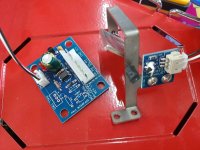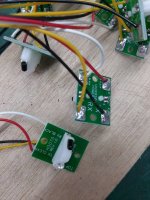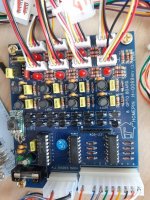Pinball info
You are using an out of date browser. It may not display this or other websites correctly.
You should upgrade or use an alternative browser.
You should upgrade or use an alternative browser.
@Neil McRae - I do and I am grateful for that, I am even more upset by the whole thing that to be honest. Whilst many people who have been on the wrong side of you call you out for being a bully etc. etc. I never experienced it. The fact that its got to this point and you didn't think you could call me up and say, "hey I have an issue with this this and this and have you considered how it may impact that that and that", perhaps it would've helped us do something better, or change the view on it. Instead its been a barage of crap and you've just decided to take on this crusade to dig at anything you can. As I said before, call me up, lets have a chat.
I think kicking off at you is a little harsh , but I called you on something and you still haven't responded. As I know, not because of anything other than their policy, Mezel won't ship to the UK now.
I don't thnk Pinball Bazaar is trying to rip anyone off, you can still buy from the USA such as Marco if you like and you have. Mezel just don't supply into the UK as a policy issue for them. IF the £ is so much stronger now and it makes sense, then I emplor anyone to do that that feels its best for them You can buy from the EU too if you'd like. It isn't a monopoly, there's a tonne of choice out there for loads of options. We won't please 100% of the people 100% of the time, we do our best, but I get it, not everyone wants to buy from us and that's fine.
With Alien, we aren't ripping anyone off either, we have taken deposits, which we are holding, 100% refundable - or for LE's secured spaces for games that people want, unseen and that's their perogotive. We don't require a penny for those becuase - how can you take a penny for that? Alien has a history, that's true and no one can deny that, but you also cannot deny that people will want it. So, we thought it would be a good opportunity to supply it, hopefully people would recognise that we would charge the market rate for it (not like someone like HLD) and their money would be safe with us. I think that was the lesser of the evils than HLD winning it, or someone else and people in the community, who want it, and they do, paying an extra £2k on it becuase someone else got the rights to it. Silly, maybe - I don't know.
I think kicking off at you is a little harsh , but I called you on something and you still haven't responded. As I know, not because of anything other than their policy, Mezel won't ship to the UK now.
I don't thnk Pinball Bazaar is trying to rip anyone off, you can still buy from the USA such as Marco if you like and you have. Mezel just don't supply into the UK as a policy issue for them. IF the £ is so much stronger now and it makes sense, then I emplor anyone to do that that feels its best for them You can buy from the EU too if you'd like. It isn't a monopoly, there's a tonne of choice out there for loads of options. We won't please 100% of the people 100% of the time, we do our best, but I get it, not everyone wants to buy from us and that's fine.
With Alien, we aren't ripping anyone off either, we have taken deposits, which we are holding, 100% refundable - or for LE's secured spaces for games that people want, unseen and that's their perogotive. We don't require a penny for those becuase - how can you take a penny for that? Alien has a history, that's true and no one can deny that, but you also cannot deny that people will want it. So, we thought it would be a good opportunity to supply it, hopefully people would recognise that we would charge the market rate for it (not like someone like HLD) and their money would be safe with us. I think that was the lesser of the evils than HLD winning it, or someone else and people in the community, who want it, and they do, paying an extra £2k on it becuase someone else got the rights to it. Silly, maybe - I don't know.
Last edited:
Let's get back on topic, eh?
- Joined
- Jul 21, 2011
- Messages
- 3,848
Hi Guys,
We were contracted by Porsche to build some promotional pinball machines to help them promote their new Taycan electric car. These machines will not be available for sale to the public and, interestingly, my inbox has been flooded with requests to buy one from many different countries.
The playfield layout and all artwork was supplied by Porsche and Homepin had no say or input for design and art at all. I personally made it very clear to their advertising agency that the cabinets, playfield & plastics should have a lot more colour but they held fast to their design.
There are some of our new inovations built in such as opto rollovers that are controlled by a special circuit to prevent false triggering from ambient light and also the spinner is using a hall effect device to allow it to spin freely without a micro slowing it down. There are several other small innovations that we will use in all new machines moving forward.
I'm unsure why all the hate directed at Homepin and myself? I would have thought any new promotion of pinball could only be a good thing but there you go, what would I know.
Good score there with the Porsche contract i hope it helps you expand further Mike.
Any more pics/details you can share with us?
I remember seeing several Porsche-Pirelli-Super-cup races years ago. Always a lot of comedy. They had pit lane girls then too... hey ho.Let's get back on topic, eh?
Does Steve Ritchie get a design credit as it sure looks like firepower to me? Someone at Porsche has good taste
I believe we are now back on track - my work here is done - I'll get my coat.
Neil must be busy applying for that slot that opened up on Good Morning Britain 
Neil would have an advantage on the voice mail hacking part of that job description lol
Any more pics/details you can share with us?
As some have noticed the layout is, in some ways, similar to Firepower. It is a tried and true layout that is much loved. There are quite a few differences though. We have included two sets of drop targets. Yes, I am aware these were 'supposed' to be included in the original Firepower but were left out due cost constraints - fact is they were NOT included in Firepower so that makes this game better to play IMO.
Homepin concentrates on making improvements NOT in making blockbuster titled machines that are churned out. We are simply not geared up for huge production runs, even less so since we moved to Taiwan. Our factory here is much smaller and we are still training staff up and finding local suppliers. It is our intention to farm out much of the donkey work that we did in house before such as cabinet building.
For those not up with the politics of the region, Chinese nationals are not permitted to travel to Taiwan, especially for work. We would have loved to bring a few key staff with us but Pooh Bear simply won't allow Chinese to travel to Taiwan. Their loss not Taiwan's.
Our new spinner assembly works using a hall effect sensor, IE magnetism. This allows the spinner to spin a lot more than it would if there was a microswitch that mechanically slows every revolution. It also doesn't require any adjustment so more reliability. The Porsche machines (PT) only have one spinner, our interface board allows for two, but as the pic shows, it is only populated for one in this instance. The output of this interface board connects directly to the row and column of the switch matrix meaning our spinner could be easily and directly installed in any pinball machine that uses a switch matrix. We may look to having these (and some other stuff) available for home builders in the future. We have built them (brackets and PCBs) in both left and right versions.
The infra-red lane switch optos have been in development for a very long time. Actually it was the upright ball balance game, Ride The Wave, that brought this development forward. We designed circuitry that has a similarity to the 24" opto circuit in BSD with a few tweaks of our own. It is almost impervious to ambient light - you can wave a very bright torch right on top of a sensor assembly and 99% of the time it will be ignored. With the machine in full daylight there is no difference between our sensors and microswitches.
So why haven't they been used before? Very easy to answer, COST! These cost a LOT more to make than conventional switches. All sensor boards run back to a main processing board that (again) is connected to the standard switch matrix using opto isolators. There is a small microcontroller on this board that contains some 'tricks' of our own design. There are a lot more tricks getting this system to work correctly that took us a lot of development time to get just right. There is also a LED for each sensor channel on the main interface board to easily check operation of each sensor. I expect we will use these for all games in the future, certainly that is the current intention.
I can't share any more pics of the PT at this point.



Well he does have an opinion on everything so very similar to the host who just left eh?Neil must be busy applying for that slot that opened up on Good Morning Britain
How many are you producing, Mike? Would be good to get one over to the UK for a future event if possible. Although I'm guessing Porsche will be taking the lot.
Great idea with the spinner, no slow down from the switch. Would love to add these to my pins. If this pin is the first to use it maybe call it the ‘turbo spinner’
How many are being made?
How many are being made?
As some have noticed the layout is, in some ways, similar to Firepower. It is a tried and true layout that is much loved. There are quite a few differences though. We have included two sets of drop targets. Yes, I am aware these were 'supposed' to be included in the original Firepower but were left out due cost constraints - fact is they were NOT included in Firepower so that makes this game better to play IMO.
Homepin concentrates on making improvements NOT in making blockbuster titled machines that are churned out. We are simply not geared up for huge production runs, even less so since we moved to Taiwan. Our factory here is much smaller and we are still training staff up and finding local suppliers. It is our intention to farm out much of the donkey work that we did in house before such as cabinet building.
For those not up with the politics of the region, Chinese nationals are not permitted to travel to Taiwan, especially for work. We would have loved to bring a few key staff with us but Pooh Bear simply won't allow Chinese to travel to Taiwan. Their loss not Taiwan's.
Our new spinner assembly works using a hall effect sensor, IE magnetism. This allows the spinner to spin a lot more than it would if there was a microswitch that mechanically slows every revolution. It also doesn't require any adjustment so more reliability. The Porsche machines (PT) only have one spinner, our interface board allows for two, but as the pic shows, it is only populated for one in this instance. The output of this interface board connects directly to the row and column of the switch matrix meaning our spinner could be easily and directly installed in any pinball machine that uses a switch matrix. We may look to having these (and some other stuff) available for home builders in the future. We have built them (brackets and PCBs) in both left and right versions.
The infra-red lane switch optos have been in development for a very long time. Actually it was the upright ball balance game, Ride The Wave, that brought this development forward. We designed circuitry that has a similarity to the 24" opto circuit in BSD with a few tweaks of our own. It is almost impervious to ambient light - you can wave a very bright torch right on top of a sensor assembly and 99% of the time it will be ignored. With the machine in full daylight there is no difference between our sensors and microswitches.
So why haven't they been used before? Very easy to answer, COST! These cost a LOT more to make than conventional switches. All sensor boards run back to a main processing board that (again) is connected to the standard switch matrix using opto isolators. There is a small microcontroller on this board that contains some 'tricks' of our own design. There are a lot more tricks getting this system to work correctly that took us a lot of development time to get just right. There is also a LED for each sensor channel on the main interface board to easily check operation of each sensor. I expect we will use these for all games in the future, certainly that is the current intention.
I can't share any more pics of the PT at this point.
View attachment 134485
View attachment 134483
View attachment 134484
Always been annoyed at spinners being slowed down by switches.
Older switches were fine, spinners were great but certainly worse in more modern times
I answer customer messages many times a week and usually within hours of receiving them. I have no messages (certainly not in the last 12 months) about our strobe board from anyone?
Are you using a 'normal' email address or something obscure that might be blocked my end?
For some advance help - Our circuit front end is IDENTICAL to the original so this board should have no effect on the operation of the game that is different to the original and it is opto isolated (like the original) so again it can't impact on the game differently to the original. We made changes to the high voltage section which is one reason we supply a new flash tube as well because sometimes our high voltage circuit isn't compatible with the original which is often 20 years old and flaky at best.
Happy to help as always at support@homepin.com


